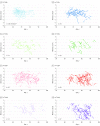Associations of Amyloid, Tau, and Neurodegeneration Biomarker Profiles With Rates of Memory Decline Among Individuals Without Dementia
- PMID: 31211344
- PMCID: PMC6582267
- DOI: 10.1001/jama.2019.7437
Associations of Amyloid, Tau, and Neurodegeneration Biomarker Profiles With Rates of Memory Decline Among Individuals Without Dementia
Abstract
Importance: A National Institute on Aging and Alzheimer's Association workgroup proposed a research framework for Alzheimer disease in which biomarker classification of research participants is labeled AT(N) for amyloid, tau, and neurodegeneration biomarkers.
Objective: To determine the associations between AT(N) biomarker profiles and memory decline in a population-based cohort of individuals without dementia age 60 years or older, and to determine whether biomarkers provide incremental prognostic value beyond more readily available clinical and genetic information.
Design, setting, and participants: Population-based cohort study of cognitive aging in Olmsted County, Minnesota, that included 480 nondemented Mayo Clinic Study of Aging participants who had a clinical evaluation and amyloid positron emission tomography (PET) (A), tau PET (T), and magnetic resonance imaging (MRI) cortical thickness (N) measures between April 16, 2015, and November 1, 2017, and at least 1 clinical evaluation follow-up by November 12, 2018.
Exposures: Age, sex, education, cardiovascular and metabolic conditions score, APOE genotype, and AT(N) biomarker profiles. Each of A, T, or (N) can be abnormal (+) or normal (-), resulting in 8 AT(N) profiles.
Main outcomes and measures: Primary outcome was a composite memory score measured longitudinally at 15-month intervals. Analyses measured the associations between predictor variables and the memory score, and whether AT(N) biomarker profiles significantly improved prediction of memory z score rates of change beyond a model with clinical and genetic variables only.
Results: Participants were followed up for a median of 4.8 years (interquartile range [IQR], 3.8-5.1) and 44% were women (211/480). Median (IQR) ages ranged from 67 years (65-73) in the A-T-(N)- group to 83 years (76-87) in the A+T+(N)+ group. Of the participants, 92% (441/480) were cognitively unimpaired but the A+T+(N)+ group had the largest proportion of mild cognitive impairment (30%). AT(N) biomarkers improved the prediction of memory performance over a clinical model from an R2 of 0.26 to 0.31 (P < .001). Memory declined fastest in the A+T+(N)+, A+T+(N)-, and A+T-(N)+ groups compared with the other 5 AT(N) groups (P = .002). Estimated rates of decline in the 3 fastest declining groups were -0.13 (95% CI, -0.17 to -0.09), -0.10 (95% CI, -0.16 to -0.05), and -0.10 (95% CI, -0.13 to -0.06) z score units per year, respectively, for an 85-year-old APOE ε4 noncarrier.
Conclusions and relevance: Among older persons without baseline dementia followed for a median of 4.8 years, a prediction model that included amyloid PET, tau PET, and MRI cortical thickness resulted in a small but statistically significant improvement in predicting memory decline over a model with more readily available clinical and genetic variables. The clinical importance of this difference is uncertain.
Conflict of interest statement
Figures




Comment in
-
Putting the New Alzheimer Disease Amyloid, Tau, Neurodegeneration (AT[N]) Diagnostic System to the Test.JAMA. 2019 Jun 18;321(23):2289-2291. doi: 10.1001/jama.2019.7534. JAMA. 2019. PMID: 31211328 Free PMC article. No abstract available.
References
Publication types
MeSH terms
Substances
Grants and funding
LinkOut - more resources
Full Text Sources
Medical
Miscellaneous

